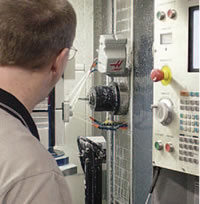
Bringing all aspects of coolants together into one system, the recycling process works to keep coolants at their peak operating condition. Incorporating concentration control, biological control, liquid/solid contamination control, and testing to assure additive control, recycling coolants is the most effective way to ensure optimal performance.
Wrapped around your recycling system is a formal record keeping and testing procedure. You can be in complete control of contamination, yet still face problems like corrosion, foam and operator complaints. Working in conjunction with your coolant vendor, detailed records should be kept on ph, tramp oil, temperature, concentration, bacteria count, and water additions. All chemical additions and any abnormal events should be noted. Your coolant supplier should provide a monthly report on cast iron chip testing for corrosion, tramp oil content and sediment.
Recycling systems can be purchased as complete units or assembled as parts. Purchasing complete units helps assure your application is correct for the type and size of the unit. The most common measure for sizing units is gallons per minute. Determining the correct processing rate is the single most important factor in a successful system. To do this we have to know how much coolant is to be processed and how much time (or number of rotations) in the recycling system will be required.
Before you look at technologies, understand your shop. Every machine tool should be listed and the following questions answered.
If you work with a central sump, these same questions can be modified and answered. For individual machines, compile this information into a total value for the shop.
The information gathered from your survey will allow you to begin the process of finding a recycling unit for your shop. Similarly, a shop survey will also produce an answer to the most important question of all, “Does it make economic sense to invest in this project?”
Whatever equipment you choose, make sure it filters fines and debris, removes tramp oil, and (in some cases) separates chips from the coolant.
Recycling equipment can be classified into three general categories: Portable, Centralized and Dedicated.
Portable Recycling — A portable unit is intended for shops of 50 machine tools or less. The unit is wheeled up to a machine and connected to the sump to circulate the coolant through the system. The length of the process depends upon the sump size and the number of gallons per minute processed by the unit. Unfortunately, these systems generally do not remove chips that have settled in the sump.
Centralized Recycling — A central recycling system is targeted at 25 -100 machine tools. That figure depends on the transport unit (usually a sump sucker) used to extract the dirty coolant, debris and chips from the sump and return it to the central processing unit. Clean coolant can be returned to the sump via a clean compartment in the sump sucker, or a delivery line from the central unit. In order to maintain an adequate supply of clean coolant for daily replenishment of the sumps, the central unit must be sized correctly.
Dedicated Recycling Systems - Dedicated systems are permanently mounted on a large machine sump or central coolant system. Complete recycling systems usually feature a large filtration capacity for chips, tramp oils and fines.
The development of your recycling system should not be done without the participation of your coolant manufacturer. Be aware however, the manufacturer may have a preferred in-house system that they're required to sell to their customers. Manufacturer's systems are often over priced and designed exclusively for use on their own products. When purchasing your system, always consider what your suppliers recommend, but never overlook competing technologies.
Bringing in an independent dealer assures that you will get the best equipment for the best price. Moreover, you’ll have the freedom of being able to change coolant suppliers without running the risk of rendering your system obsolete.
Your shop survey and financial analysis will allow you to evaluate equipment recommendations. Your final selection should be based upon its user friendliness, its fit within your preventive maintenance capabilities and its economic justification. Before the final purchase is made, always visit with those who are currently working with the same system and ask about their experiences.
|
ETNA Products 16824 Park Circle Drive, Chagrin Falls, Ohio 44023 Phone: 800-229-3862 / 440-543-9845 Fax: 440-543-1789 Copyright ©2025 ETNA Products, Inc. KOOLRite and SynMAX are trademarks of ETNA Products, Inc. |